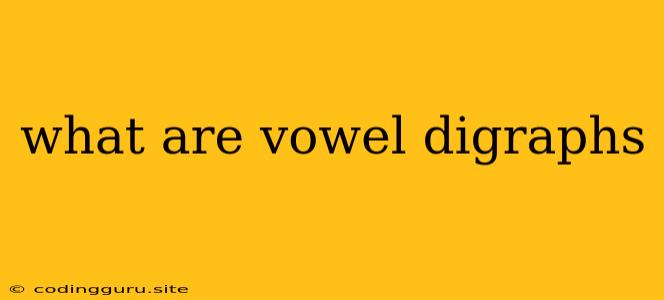What are Vowel Digraphs?
Ever wondered why words like "boat" and "rain" are spelled with two letters for a single vowel sound? This is because they contain vowel digraphs, a common feature in the English language. But what exactly are vowel digraphs, and how do they work? Let's dive in.
What are Vowel Digraphs?
Vowel digraphs are combinations of two letters, usually vowels, that represent a single vowel sound. These combinations can be tricky for learners as they don't follow the typical "one letter, one sound" rule.
For example, in the word "boat", the letters "oa" together make the /oʊ/ sound, not the individual sounds of "o" and "a". Similarly, in "rain", the letters "ai" represent the /eɪ/ sound.
How do Vowel Digraphs Work?
Vowel digraphs are like shortcuts in the English spelling system. They help us represent sounds that cannot be easily captured with a single letter. Over time, the English language has evolved, and vowel digraphs have become a useful tool to represent these complex sounds.
Why Learn about Vowel Digraphs?
Understanding vowel digraphs is crucial for improving reading and spelling skills. It helps you:
- Decode words: Recognize the sound represented by the vowel digraph and decipher the word accurately.
- Spell correctly: Know which vowel digraph to use for a particular sound.
- Improve reading fluency: Recognize words quickly and confidently, boosting comprehension.
Examples of Common Vowel Digraphs
Let's look at some common vowel digraphs and their corresponding sounds:
| Digraph: | Sound: | Example: |
|---|
- ai | /eɪ/ | "rain", "train", "wait"
- ay | /eɪ/ | "say", "day", "play"
- ee | /iː/ | "tree", "see", "bee"
- ea | /iː/ | "sea", "tea", "read"
- ie | /iː/ | "lie", "tie", "pie"
- oa | /oʊ/ | "boat", "coat", "road"
- ow | /aʊ/ | "cow", "now", "how"
- oi | /ɔɪ/ | "coin", "boil", "join"
- oo | /uː/ | "moon", "food", "school"
- ou | /aʊ/ | "house", "mouse", "about"
Note: Some vowel digraphs may have different pronunciations depending on the word. For instance, "ea" can also represent the /ɛ/ sound as in "bread" or the /i/ sound as in "head".
Tips for Learning Vowel Digraphs
- Use flashcards: Create flashcards with the vowel digraph on one side and the sound it represents on the other.
- Practice reading: Read words and sentences containing vowel digraphs aloud to familiarize yourself with their sounds.
- Play games: Use word games and puzzles that focus on vowel digraphs to make learning fun.
- Use a dictionary: Look up unfamiliar words with vowel digraphs to understand their pronunciation and spelling.
Conclusion
Vowel digraphs are a vital part of English spelling. Understanding their meaning and pronunciation significantly improves reading and spelling skills. By familiarizing yourself with common vowel digraphs and their sounds, you can confidently decode words and improve your overall literacy. Don't be intimidated by these seemingly complex combinations. With practice and a little effort, you can master vowel digraphs and become a more confident reader and writer.
